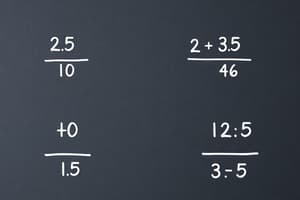Podcast
Questions and Answers
What is the result of adding the fractions 1/2 and 1/4?
What is the result of adding the fractions 1/2 and 1/4?
- 3/4 (correct)
- 1/6
- 2/6
- 5/8
What is the result of subtracting the fraction 1/2 from 2/3?
What is the result of subtracting the fraction 1/2 from 2/3?
- 1/3 (correct)
- 1/6
- 2/5
- 1/2
Which of the following is an equivalent fraction to 2/5?
Which of the following is an equivalent fraction to 2/5?
- 8/20
- 6/15
- 4/10 (correct)
- 10/25
What is the place value of the digit 7 in the decimal number 3.74?
What is the place value of the digit 7 in the decimal number 3.74?
What is the result of subtracting the fraction 3/10 from 2/5?
What is the result of subtracting the fraction 3/10 from 2/5?
What is the sum of 1/4 and 1/2?
What is the sum of 1/4 and 1/2?
Which of the following fractions is equivalent to 3/6?
Which of the following fractions is equivalent to 3/6?
What is the value of 0.025 in fraction form?
What is the value of 0.025 in fraction form?
If you subtract 0.7 from 1.2, what is the result?
If you subtract 0.7 from 1.2, what is the result?
Which of the following represents seventy-five thousandths?
Which of the following represents seventy-five thousandths?
Flashcards are hidden until you start studying
Study Notes
Fractions and Decimals: Understanding Addition, Subtraction, Equivalence, and Place Value
Introduction
A fraction represents a part of a whole or a quotient of two quantities, whereas a decimal consists of whole numbers and a fraction written in front of a decimal point. Both concepts are essential in understanding mathematical operations involving numbers such as addition, subtraction, multiplication, and division. Let us explore the intricacies of adding and subtracting fractions, determining their equivalence, and comprehending decimal place value.
Adding Fractions
When adding fractions, we ensure that they share a common denominator and then add the numerators together. For instance, let's consider 1/2 + 1/4. We find a common multiple of 2 and 4, which is 4. Then, we write the sum as 3/4. Similarly, 1/3 + 2/6 can be added as 4/6, which equals 2/3 since 6 is already a factor of 9.
Subtracting Fractions
Subtracting fractions involves finding the difference between the numerators while keeping the common denominator constant. For example, subtracting 1/2 from 2/3 gives us 1/3. Likewise, 2/5 - 3/10 equals -1/5 because both fractions have a common denominator of 10.
Equivalent Fractions
Equivalent fractions are different expressions that represent the same ratio. To create equivalent fractions, we multiply the numerator and denominator of one fraction by the same factor without changing their ratio. For example, 1/5 and 2/10 are equivalent fractions since they both represent one part out of five. Similarly, 1/7 and 2/14 are equivalent fractions representing one part out of seven.
Decimal Place Value
When expressing numbers as decimals, place value plays a crucial role. We interpret the digits after the decimal point based on their position relative to the decimal point. The rightmost digit corresponds to hundredths, followed by thousandths. For instance, 0.4 has only one digit to the right of the decimal point, so it represents four-tenths. On the other hand, 0.075 consists of two digits after the decimal point, indicating seventy-five thousandths.
To add or subtract decimals, we follow similar principles as with whole numbers. We align the columns according to their place values and perform arithmetic operations between corresponding digits. For example, considering 0.3 + 0.2 = 0.5, we line up the decimal points below each other, then add the first column (0 + 2 = 2) and carry over if necessary. Finally, we write down the result with appropriate place value labels.
In conclusion, understanding fractions and decimals involves grasping the concepts of adding and subtracting these numerical representations, determining equivalence, and comprehending place value in decimal notation. With practice and patience, these skills can be mastered, enabling students to tackle various mathematical problems involving fractions and decimals confidently.
Studying That Suits You
Use AI to generate personalized quizzes and flashcards to suit your learning preferences.




